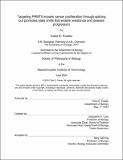Targeting PRMT5 impairs cancer proliferation through splicing but promotes state shifts that enable resistance and disease progression
Author(s)
Fowler, Colin E.
DownloadThesis PDF (154.8Mb)
Advisor
Lees, Jacqueline A.
Terms of use
Metadata
Show full item recordAbstract
Epigenetic regulators play key roles in disease and development. Cancers can hijack developmental processes and mechanisms to grow and survive, including re-activating expression of epigenetic regulators normally confined to developing cells. One such regulator is protein arginine methyltransferase 5 (PRMT5), which methylates proteins involved in transcription, splicing, and translation. PRMT5 is expressed in a wide variety of tumor types, and preclinical studies show that PRMT5 inhibitors (PRMT5i) effectively suppress cancer cell proliferation. Despite this success, resistance to targeted therapies is inevitable. This thesis addresses the mechanism by which resistance to PRMT5 inhibition is established, the clinical consequences of resistance, and the basis for cancer’s dependance on PRMT5.
We establish the first model of resistance to PRMT5i treatment. We show that lung adenocarcinoma (LUAD) cell lines initially respond to treatment, but resistance arose rapidly through Lamarckian induction. The resistant state is stable, but brings with it a number of collateral sensitivities, including to the chemotherapeutic paclitaxel. Both PRMT5i resistance and collateral paclitaxel sensitivity depend on stathmin 2 (Stmn2), a microtubule regulator specifically expressed in resistant cells. This observation has direct clinical relevance, as co-treatment with PRMT5i and taxanes was highly effective at killing multiple cancer cell lines, and suppressed the emergence of PRMT5i resistance. Moreover, analysis of patient data showed that STMN2 levels serve as a biomarker to predict patient response to taxanes.
We also addressed the clinical implications of the PRMT5i resistant state. We showed that resistance was marked by transcriptional and chromatin changes that drove LUAD into a more dedifferentiated state, mimicking late-stage disease. Accordingly, transplant experiments showed that resistant lines are more metastatic than their parental counterparts. Mechanistically, short-term PRMT5i treatment triggered widespread chromatin accessibility changes, imbuing the cells with the plasticity to sample, and select for, the chromatin state that provides PRMT5i-resistance. Finally, in vivo PRMT5i treatment increased murine lung tumor grade, without decreasing tumor burden. Collectively, these data show that PRMT5i resistance in LUAD is a clear clinical possibility, and that resistance will likely be accompanied by increased disease progression.
Finally, we explored the mechanistic bases for cancer cells’ vulnerability to PRMT5 inhibition. We focused on the prevailing view that the PRMT5-splicing axis is critical, developing a system that allows inducible depletion of a PRMT5 cofactor, CLNS1A, to specifically inhibit PRMT5-mediated methylation of the spliceosomal Sm proteins. We established that many cell lines respond to CLNS1A depletion, showing loss of Sm protein methylation and corresponding loss of cell viability, but others were inherently resistant. In the resistant lines, CLNS1A is fully dispensable, but its depletion sensitized cells to PRMT5 inhibition. Splicing analysis, comparing CLNS1A-dependent and independent lines, established that the degree of sensitivity to CLNS1A depletion reflects the level of splicing defects, and particularly the induction of detained introns. Together, this data suggest that aberrant splicing, specifically detained intron formation, underlies cancer’s vulnerability to PRMT5 inhibition.
Date issued
2024-05Department
Massachusetts Institute of Technology. Department of BiologyPublisher
Massachusetts Institute of Technology